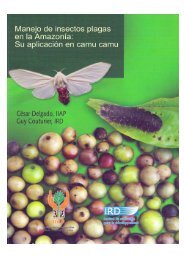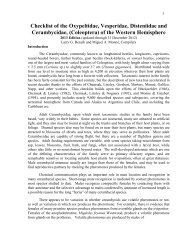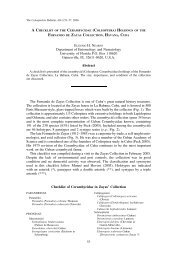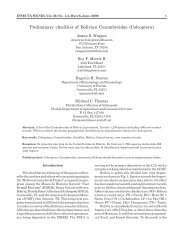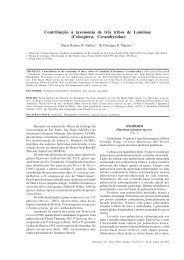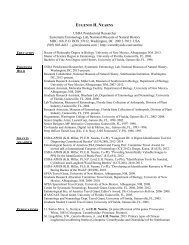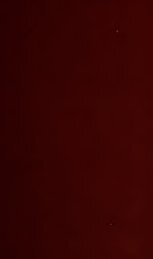Create successful ePaper yourself
Turn your PDF publications into a flip-book with our unique Google optimized e-Paper software.
148 THE TRIBE .ONCIDERINI<br />
then arcuately expanded to near apex, where it is strongly na.rrowed so that apical<br />
margin is not quite so wide as basal margin, lateral tubercles wanting; apical tmnsverse<br />
sulcus entirely obsolete and apex without beading, bnsai transverse sulcus<br />
deep, trisinuOU3, on each side two distinct sulci, ODe in position of usual lateral<br />
oblique sulcus, nearly, but not quite extending onto disk, the other extending the<br />
basal sulcus but not connected to it; disk at center tumid, bearing three tubercles<br />
there, a low elongate median one, and one each side anteriorly, oval, more prominent,<br />
lateral to the tumescence is an elongate, low, strongly oblique tubercle each side.<br />
Scutellum nearly as long as wide; sides straight, oblique; apex narrow, truncate.<br />
Elytra with sides nearly parallel, apices separately rounded ; oosal gibbosity rather<br />
elongate, oval, prominent, covered fairly densely with coarse punctures, each of<br />
which anteriorly bears a transverse granule, more pronounced near base; disk<br />
rather coarsely punctate, punctures gradually more sparse to middle, thence to<br />
apex denser and obsolete; humeri projecting, anterior margin feebly arcuate, slightly<br />
oblique, angle with a strong, transverse tubercle, prolonged beneath into a short,<br />
obique l carina. and above by a series of transverse rugosities. Prostcrnum simple,<br />
narrow, nearly parallelsided, at base strongly expanded ; mesosternal process wide,<br />
gradually e:panded basally, apex bilobedly emarginate. Procoxae globose, anteri<br />
orly with a broad, feeble tubercle; femora rather slender, clavate, profemora not<br />
rugo..."C. Fifth sternite nearly twice length of fourth, a large, triangular flattened<br />
area apically, apex feebly arcuate. Antennae one and onefourth times as long as<br />
body, eighth segment surpassing eiytral apex, very sparsely fimbriate beneath on<br />
third and fourth segments ; scape slender, slightly clavate on apical hnlf, not rugose<br />
at base; third segment about one-fifth longer than first, robust, feebly sinuous,<br />
fourth nnd fifth ' equnl to scape, rest slightly shorter, subequal.<br />
LFlNGTH 13 mm.; width 5 tnm.<br />
Holotype.-Female ; Santarem, Brazil i [C.M.].<br />
HESYCHOTYPA Thomson<br />
He8Ychotypa Thomson, Pbysis, n, 1868, p. 53. Lacorda.ire, Gen. Col., IX, 1872,<br />
p. 667, 672.<br />
The chief distinguishing characteristics of the genus are as<br />
follows : the cJytra simply punctate, not granulate at base; antennae<br />
with third segment much longer than scape, moderately sin<br />
nate, scape short, robust, clavate; mesosternal process angulate<br />
each side, apex emarginate j humeri only sligl1tly prominent, an<br />
terior margin strongly arcnate j head and pronotum always with<br />
alternate dark and pale vittae.<br />
Elongat.e-ovate, robust; dark reddishbrown to black, tlSUllIly with a median or<br />
post-median fascia on elytra, which are often more or less covered with strigiform<br />
pubescent markings. Head with eye very variable in size and shape; front broad,<br />
only slightly higher than wide, parnllelsided or slightly narrowed below eyes; Rn<br />
tennal tubercles slightly prominent, widely separated, in male usually with a short<br />
horn, in female only slightly produced. Pronotum rather strongly transverse, apcx


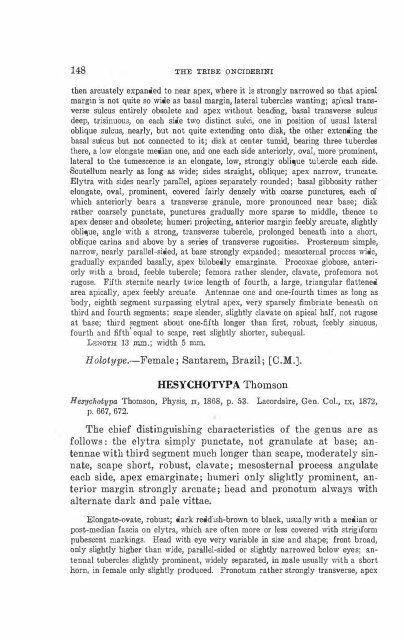
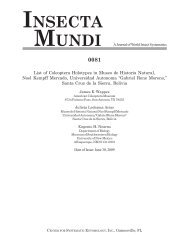
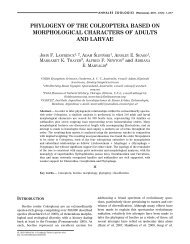


![Coleoptera. Vol. I. [Longicornia. Part I.]](https://img.yumpu.com/41202793/1/180x260/coleoptera-vol-i-longicornia-part-i.jpg?quality=85)
